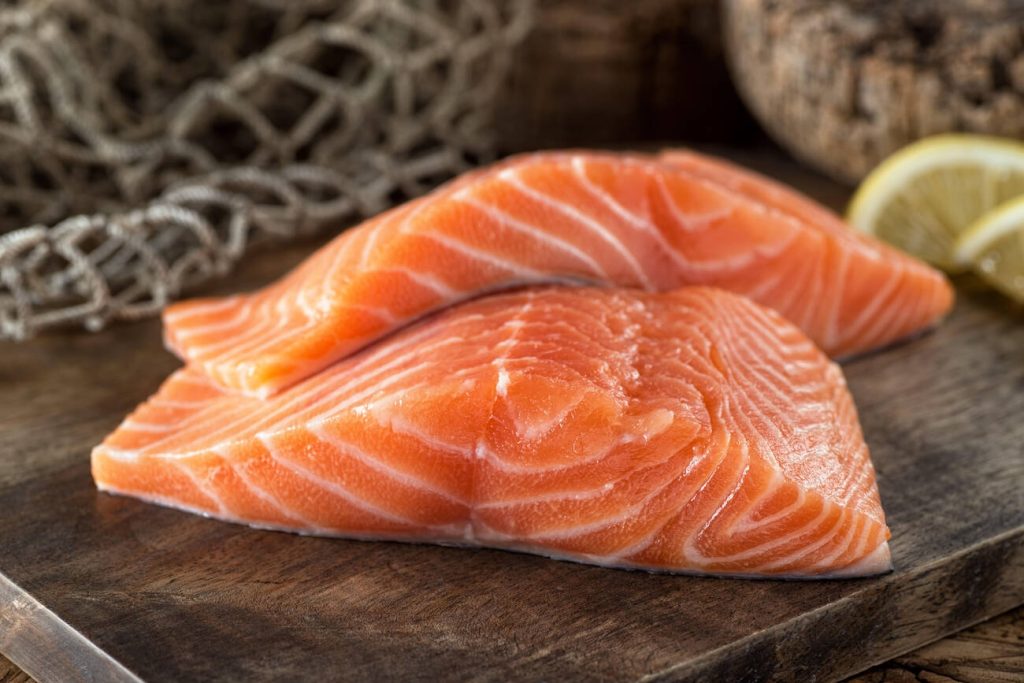By partnering with trusted organizations like the Marine Stewardship Council and the Monterey Bay Aquarium Seafood Watch program, Whole Foods guarantees that their salmon is sourced from well-managed fisheries. Get ready to dive into the world of sustainable salmon farming and discover the delicious and conscientious choices available at Whole Foods.
Whole Foods’ Commitment to Sustainability
Whole Foods is committed to sustainability by ensuring that their seafood, including farm-raised salmon, meets strict protocols to prevent escapes, use of antibiotics, synthetic pesticides, and added growth hormones. They collaborate with the Marine Stewardship Council (MSC), a leading certification program for sustainable wild-caught seafood. This collaboration ensures healthy fish populations and ecosystems. Whole Foods also holds sustainable seafood certifications and follows responsible farming practices.
Transparency is important to Whole Foods, as they believe consumers should know where their food comes from. They prioritize traceability by conducting multiple third-party audits and ensuring that all salmon sold can be traced from farm to store.
Sustainable salmon farming has a positive environmental impact as it reduces pressure on wild fish populations and promotes responsible aquaculture practices. Consuming sustainable seafood not only supports the health of our oceans but also provides benefits like high-quality nutrients and delicious flavors.
The Importance of Sustainable Salmon Farming
When choosing seafood, it’s important to support responsible farming practices that prioritize the health of fish populations and ecosystems. One such practice is sustainable salmon farming. Sustainable seafood certifications ensure that the salmon you choose has been raised in a way that minimizes its impact on the environment. By opting for wild-caught salmon, you support the preservation of fish populations and their natural habitats. Responsible farming practices also promote traceability in the seafood industry, allowing consumers to know exactly where their seafood comes from. Not only does choosing sustainable seafood help protect our oceans, but it also ensures that you are consuming high-quality, nutritious fish. So next time you’re at the market, look for sustainable certifications and make a conscious choice to support responsible farming practices by choosing wild-caught salmon.
Responsible Farming Practices at Whole Foods
Make sure to look for the responsible farming certifications when choosing seafood at our market. Here are four reasons why responsible farming practices at Whole Foods are important for the environment and fish population management:
- Responsible Farming Techniques: Our farm-raised salmon is raised using sustainable aquaculture methods, which prioritize the well-being of the fish and minimize environmental impact.
- Environmental Impact: By utilizing responsible farming techniques, we actively work to reduce pollution, protect water quality, and preserve ecosystems in order to maintain a healthy balance in marine environments.
- Fish Population Management: Our commitment to responsible farming ensures that we carefully manage fish populations, avoiding overfishing and promoting sustainable practices that support long-term abundance.
- Ecosystem Preservation: Through our efforts in responsible aquaculture, we strive to protect and preserve the delicate ecosystems that surround our farms, safeguarding biodiversity and maintaining a thriving natural environment.
The Role of Traceability in Sustainable Salmon Production
When selecting seafood from our market, you’ll find that traceability plays a crucial role in ensuring sustainable production of this popular fish. Traceability allows us to track the journey of each salmon, from its origin to your plate, providing transparency and accountability throughout the supply chain. Not only does traceability have environmental benefits by promoting responsible fishing practices and protecting marine ecosystems, but it also meets consumer demand for knowing where their food comes from. Implementing traceability systems does come with challenges, such as the need for standardized protocols and collaboration among stakeholders. However, technology plays a significant role in overcoming these challenges by enabling real-time tracking, data management, and verification processes. The economic impact of traceability is also notable as it creates opportunities for fair trade practices and supports local communities dependent on the seafood industry.
| Economic Impact | Environmental Benefits | Consumer Demand |
|---|---|---|
| – Fair trade practices | – Promotes responsible fishing | – Transparency in food sourcing |
| – Supports local communities | – Protects marine ecosystems | – Assurance of sustainable production |
| – Creates job opportunities | – Preserves biodiversity | – Ethical purchasing choices |
Table: The Role of Traceability in Sustainable Salmon Production
Quality Assurance in Sustainable Salmon Farming
To ensure the highest quality in our responsibly farmed seafood, we implement rigorous quality assurance measures throughout the sustainable salmon farming process. Here are four ways we maintain excellence:
- Quality Control: We closely monitor every step of the salmon farming process to maintain consistent taste, texture, and freshness.
- Environmental Impact: Our sustainable practices prioritize the health of both the salmon and their surrounding ecosystems, ensuring minimal impact on the environment.
- Fish Welfare: We prioritize the well-being of our salmon by providing them with optimal living conditions, including low-density pens and a diet free from antibiotics, pesticides, and growth hormones.
- Meeting Consumer Demand: We recognize that consumers today value sustainability in their food choices. By adhering to responsible farming practices, we meet this demand while delivering delicious and nutritious salmon to our customers.
Through these measures, we are proud to offer sustainably farmed salmon that meets our high standards for quality control, environmental impact, fish welfare, and consumer demand.
Avoiding Harmful Practices in Sustainable Salmon Farming
When it comes to sustainable salmon farming, Whole Foods is committed to avoiding harmful practices and minimizing the environmental impact. They understand that worker welfare concerns are also important in the seafood industry. That’s why they prioritize transparency and advocate for regulations that protect workers’ rights.
Whole Foods ensures that their salmon farms do not engage in destructive practices that degrade both farmland and the ocean. They also go beyond label requirements by addressing worker welfare concerns, especially when it comes to imported seafood. By promoting transparency in the seafood industry, Whole Foods encourages other companies to improve their standards and regulations for worker rights.
With their dedication to avoiding harmful practices, promoting transparency, and advocating for worker welfare, Whole Foods sets a higher standard for sustainable salmon farming. They strive to create a positive impact on both the environment and the people involved in the seafood industry.
The Benefits of Low-Density Salmon Farming
By choosing low-density salmon farming, you can support practices that have numerous benefits for the environment and the quality of the seafood. Here are four reasons why low-density farming is advantageous:
- Reduced Environmental Impact: Low-density farming involves fewer fish in each pen or tank, allowing for better water circulation and waste management. This helps prevent pollution and disease outbreaks, minimizing harm to the surrounding ecosystem.
- Enhanced Sustainability: With lower stocking densities, salmon farmers can ensure that their operations are more sustainable in terms of resource usage and overall impact on wild fish populations. By adopting best practices in low-density farming, they contribute to maintaining healthy fish populations for future generations.
- Improved Seafood Quality: The spacious living conditions of salmon in low-density farms allow them to swim freely and develop stronger muscles. This results in leaner and healthier fish with better taste and texture compared to those raised in overcrowded environments.
- Increased Consumer Confidence: Choosing products from responsibly farmed salmon ensures traceability, third-party audits, and strict protocols that prioritize quality assurance from farm to store. These factors give consumers confidence in the freshness, flavor, nutritional value, and safety of their seafood choices.
Overall, supporting low-density salmon farming promotes environmental stewardship while offering superior seafood options for conscious consumers like yourself
Ensuring Antibiotic-Free Salmon at Whole Foods
Ensure that you choose antibiotic-free salmon at Whole Foods to support healthier and safer seafood options. Whole Foods prioritizes preventing antibiotic resistance by prohibiting the use of antibiotics in their farm-raised salmon. They also focus on sustainable feed sources, ensuring that their salmon are fed a diet without antibiotics, pesticides, or added growth hormones. In addition to promoting environmental sustainability, Whole Foods emphasizes worker rights and transparency in the industry. Their commitment to traceability from farm to store ensures that you can trust the quality of their salmon. By choosing antibiotic-free salmon, you not only protect your health but also contribute to reducing the environmental impact of salmon farming and supporting ethical practices in the seafood industry.
| Antibiotic-Free Salmon at Whole Foods | Benefits |
|---|---|
| No use of antibiotics | Prevents antibiotic resistance |
| Sustainable feed sources | Reduces environmental impact |
| Worker rights and transparency | Supports ethical practices |
| Traceability from farm to store | Ensures quality and safety |
| Healthier and safer seafood options | Promotes personal well-being |
The Use of Natural Pigments in Sustainable Salmon Farming
Now that you understand how Whole Foods ensures antibiotic-free salmon, let’s dive into the use of natural pigments in sustainable salmon farming. Here are four important aspects to consider:
- Benefits of Natural Pigments: Salmon obtain their vibrant pink color from pigments found in their natural diet, such as krill and shrimp. By incorporating these natural pigments into the salmon feed, farmers can enhance the color without resorting to synthetic additives.
- Sustainable Farming Techniques: Responsible salmon farmers prioritize environmentally friendly practices that minimize the impact on ecosystems and promote biodiversity. This includes using low-density pens and tanks to prevent overcrowding and implementing protocols to prevent escapes into the wild.
- Environmental Impact: Sustainable salmon farming techniques aim to reduce pollution by monitoring water quality and minimizing the use of antibiotics, pesticides, and growth hormones. This helps protect marine habitats and maintain a healthy balance within aquatic ecosystems.
- Consumer Demand: As consumers become more aware of sustainability issues surrounding seafood production, their demand for responsibly farmed salmon grows. By supporting sustainable practices through their purchasing choices, consumers play a crucial role in driving positive change in the industry.
Delicious and Sustainable Salmon Recipes
Let’s explore some mouthwatering recipes that feature delicious and eco-friendly salmon. When it comes to sustainable salmon sourcing, Whole Foods Market is committed to ensuring that their farm-raised salmon meets strict protocols to prevent escapes and the use of antibiotics, synthetic pesticides, and added growth hormones. Not only does this ensure the highest quality product, but it also has a positive environmental impact. In terms of nutritional benefits, salmon is rich in omega-3 fatty acids, protein, and essential vitamins and minerals. Cooking techniques for salmon can vary from grilling to baking or even pan-searing. The flavor profiles are versatile as well, with options ranging from sweet and tangy teriyaki glazes to zesty lemon herb marinades. By choosing sustainable salmon and exploring different cooking methods and flavors, you can enjoy a delicious meal while making a positive impact on the environment.

